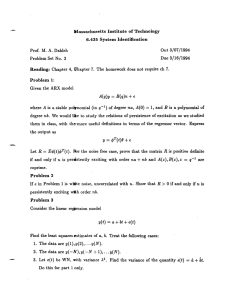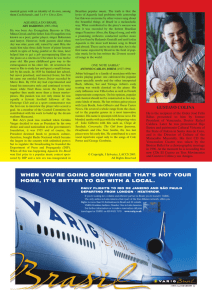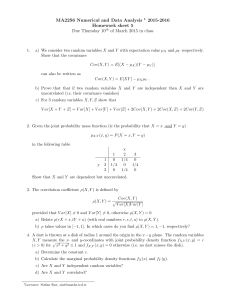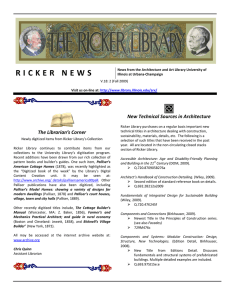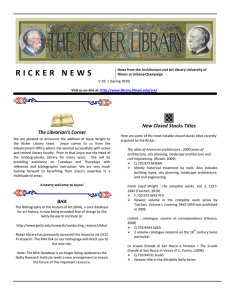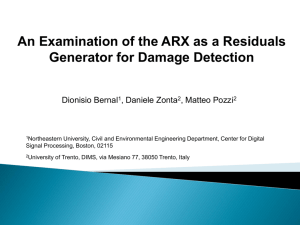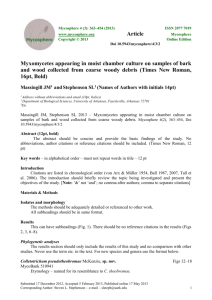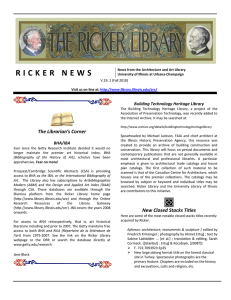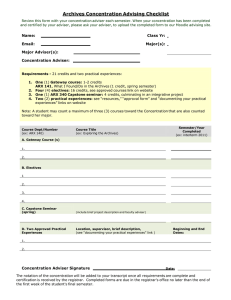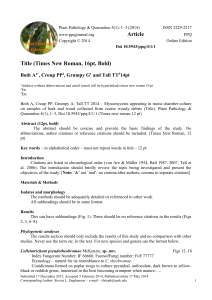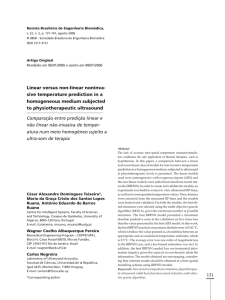14.30 Exam 2 Solutions Fall 2004 1 A: a)
advertisement
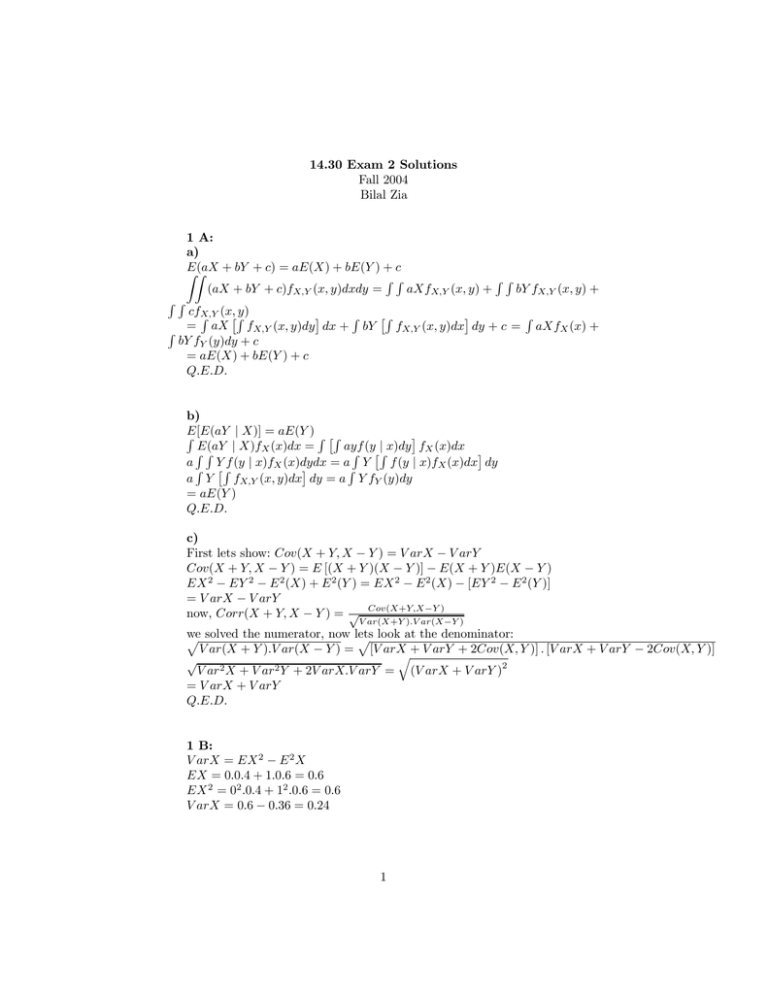
14.30 Exam 2 Solutions
Fall 2004
Bilal Zia
RR
1 A:
a)
E(aX
+ bY + c) = aE(X) + bE(Y ) + c
Z
Z
RR
RR
(aX + bY + c)fX,Y (x, y)dxdy =
aXfX,Y (x, y) +
bY fX,Y (x, y) +
cfX,Y
¤
£R
¤
R (x,£Ry)
R
R
=
aX fX,Y (x, y)dy dx + bY
fX,Y (x, y)dx dy + c = aXfX (x) +
R
bY fY (y)dy + c
= aE(X) + bE(Y ) + c
Q.E.D.
b)
¤
RE[E(aY | X)] = aE(Y ) R £R
| X)fX (x)dx =
ayf
RE(aY
R
R (y£R| x)dy fX (x)dx ¤
a R Y£Rf (y | x)fX (x)dydx
= aR Y
f (y | x)fX (x)dx dy
¤
a Y
fX,Y (x, y)dx dy = a Y fY (y)dy
= aE(Y )
Q.E.D.
c)
First lets show: Cov(X + Y, X − Y ) = V arX − V arY
Cov(X + Y, X − Y ) = E [(X + Y )(X − Y )] − E(X + Y )E(X − Y )
EX 2 − EY 2 − E 2 (X) + E 2 (Y ) = EX 2 − E 2 (X) − [EY 2 − E 2 (Y )]
= V arX − V arY
now, Corr(X + Y, X − Y ) = √ Cov(X+Y,X−Y )
V ar(X+Y ).V ar(X−Y )
we
p look at the denominator:
p solved the numerator, now lets
V ar(X + Y ).V ar(X − Y ) = [V arX
q+ V arY + 2Cov(X, Y )] . [V arX + V arY − 2Cov(X, Y )]
√
2
2
2
V ar X + V ar Y + 2V arX.V arY = (V arX + V arY )
= V arX + V arY
Q.E.D.
1 B:
V arX = EX 2 − E 2 X
EX = 0.0.4 + 1.0.6 = 0.6
EX 2 = 02 .0.4 + 12 .0.6 = 0.6
V arX = 0.6 − 0.36 = 0.24
1
Similarly, EY = 0.6P
E(Z) = E(XY ) = xyf (x, y) = 0.25
Cov(X, Y ) = E(XY ) − EXEY = 0.25 − 0.36 = −0.11
2 a:
X ∼ U (1, 3)
1
fX (x) = 3−1
= 12
Y = −α ln(3X)
Now in order to apply the 1-step method, we need to first confirm that this
function is monotonic:
dY
α
for 1 < X < 3
dX = − 3X < 0
which is monotone decreasing function in the range of X.
Range of y:
1<X <3
−α ln 9 < y < −α ln 3
where:
Y = −α ln(3X)
Y
X = 13 e− α
now 2-step method would be:
R 1 e− Yα 1
FY (y) = 1 − FX (x) = 1 − 13
2 dx
Y
Y
= 1 − 16 e− α + 12 = 32 − 16 e− α
¾
½ 1 −Y
α
for − α ln 9 < y < −α ln 3
dFY (y)
6α e
=
f
(y)
=
Y
dy
0
otherwise
and¡ 1-step ¢method would be:
1
−1
¯fX −1r ¯(y) = 2
¯ dr (y) ¯
1 −Y
e α
¯ dy ¯ = 3α
¾
½ 1 −Y
¢ ¯¯ −1 ¯¯
¡
α
for − α ln 9 < y < −α ln 3
6α e
fY (y) = fX r−1 (y) . ¯ dr dy(y) ¯ =
0
otherwise
2 b:
x
f (x) = β1 e− β for iid X1 and X2
y = max{aX1 , X2 + c}
P (Y ≤ y) = P (aX1 ≤ y).P (X2 + c ≤ y)
y
P (X
(Xi2 h≤ y − c)
hR1y ≤ a ).P
R y−c 1 − x i
x
−
1
β dx
= 0a β e β dx . 0
βe
y
y−c
y−c
y
y(a+1)−ac
= FY (y)
(1 − e− aβ ).(1 − e− β ) = 1 − e− β − e− aβ + e− aβ
)
(
y(a+1)−ac
−
− y−c
− y
aβ
β
aβ
(a+1)e
e
e
Y (y)
+ aβ −
if y (c, ∞)
=
fY (y) = dFdy
β
aβ
0
otherwise
2
3 a:
XBoston ∼ N (65, 9)
XSantiago ∼ N (60, 4)
P (XB < 66.5) = P (µ + σZ < 66.5)
where Z ∼ N (0, 1)
= P (Z < 66.5−65
)
3
= P (Z < 0.5) = 0.6915
So Probability randomly chosen woman is taller than Alice = (1 − 0.6915) =
0.3085
Number of women in Boston taller than Alice: 0.3085 ∗ 2, 000, 000 = 617, 000
3 b:
Distribution of "sum of independent normally distributed variables" is also
normal:¡
¢
1
2
so, XB
+ XB
+ XS1 + XS2 + XS3 ∼ N (µsum , σ 2sum ) ∼ N (2µB + 3µS , 2σ2B +
3σ 2B )
= N (310, 30)
3 c:
we want: P (−1 < X − µ < 1)
where X is the average height and µ is the population mean
= P ( −1
< X−µ
< √12 )
√2
√2
n
√
n
√
n
= P ( − 2 n < Z < 2n )
√
= 2P (Z < 2n ) − 1
We want at√least 95% probability:
= 2P (Z < 2n ) − 1 ≥ 0.95
√
P (Z < 2n ) ≥ 0.975
√
n
2 ≥ 1.96
n ≥ 16
4 a:
X ∼ N (50, 100)
P (40 < X < 60)
= P ( 40−50
< Z < 60−50
10
10 ) = P (−1 < Z < 1)
= 2P (Z < 1) − 1
= 2(0.8413) − 1 = 0.6826
4 b:
3
New Technology results in: X ∼ N (50, σ 2 ), where is σ2 unknown
We know: P (40 < X < 60) = 0.95
P ( 40−50
< X−50
< 60−50
σ
σ
σ ) = 0.95
−10
10
P ( σ < Z < σ ) = 0.95
2P (Z < 10
σ ) − 1 = 0.95
P (Z < 10
σ ) = 0.975
10
=
1.96
σ
σ = 5.102
so change in standard deviation is: 10 − 5.102 = 4.898
4 c:
Notice that this question points you towards another familiar distribution,
that is the binomial distribution. We are given the number of observations,and
we calculated the probability of success in part a) of this question. So we need
to plug in:
n = 555; p = 0.6826; and E(Y ) = np; V ar(Y ) = np(1 − p); so: E(Y ) =
378.843; V ar(Y ) = 120.245
where Y is represented by the binomial distribution.
Define event M =255 cathodes out of 555 satisfy customer’s specifications,
then:
µ
¶
µ
¶
n
555
m
n−m
P (M = m | n, p) =
p (1−p)
=
0.6826255 (1−0.6826)555−255
m
255
4 d:
A copper cathode
L has a price of 32 L2 cents.
R 3of law
2
Expected
price: 2 L fX (x)dx £
¤
R
= 32 L2 fX (x)dx = 32 E(X 2 ) = 32 V ar(X) + E 2 (X)
= 32 [100 + 2500] = 3900 = $39.00
4
